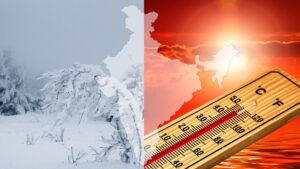As India faces a future of increasing climate extremes, new research reveals a stark toll already being paid. A study published in the journal Temperature has found that nearly 35,000 people died from extreme heat and cold between 2001 and 2019, with heatstroke emerging as the deadlier threat and men, particularly working-age men, disproportionately affected.
 The study, led by Pradeep Guin of OP Jindal Global University (JGU), analysed temperature data from the India Meteorological Department and mortality records from the National Crime Records Bureau. The researchers found 19,693 deaths due to heatstroke and 15,197 from cold exposure over the two-decade period, with a clear increase in deaths over time. The year 2015 stood out as the deadliest year, recording 1,907 heat-related and 1,147 cold-related deaths following a series of extreme weather events.
The study, led by Pradeep Guin of OP Jindal Global University (JGU), analysed temperature data from the India Meteorological Department and mortality records from the National Crime Records Bureau. The researchers found 19,693 deaths due to heatstroke and 15,197 from cold exposure over the two-decade period, with a clear increase in deaths over time. The year 2015 stood out as the deadliest year, recording 1,907 heat-related and 1,147 cold-related deaths following a series of extreme weather events.
While extreme heat is a well-known killer, especially in India’s rapidly warming cities, the study also underscores the continued threat of cold spells in several regions. States such as Andhra Pradesh, Uttar Pradesh, Punjab, Odisha, and West Bengal recorded the highest numbers of heatstroke deaths. For cold-related deaths, Uttar Pradesh, Punjab, Bihar, Haryana, and Jharkhand were among the worst hit.
One of the most striking findings of the study was the gender disparity in mortality. Men were found to be three to five times more likely to die from heatstroke and four to seven times more likely to die from cold exposure than women. The working-age group (30–59 years) was especially vulnerable. “The higher death toll from heatstroke in working-age men may reflect the fact that men are more likely to work outdoors than women,” explained Guin.
This occupational exposure includes jobs such as construction, gig economy services, and autorickshaw driving roles that demand long hours in direct sunlight and poor air quality. Guin has called for immediate policy changes, including the suspension of physically demanding outdoor work during extreme heat conditions.
However, the data also raise questions about indoor vulnerabilities, especially among women. Earlier research has shown that women in India spend 54 per cent more time indoors than men, which may lead to different but equally dangerous risks such as exposure to indoor heat, poor ventilation, and household air pollution. Ramit Debnath of the University of Cambridge told Down To Earth that Indian studies often miss these indoor population dynamics, which can distort conclusions about gender and climate vulnerability.
“We are convinced now more than ever that this is a really important policy question,” said Nandita Bhan, professor and vice dean (academic affairs) at JGU, who co-authored the study. She emphasized the need for more donor-supported research to better understand the links between climate and health outcomes.
The study also acknowledges data limitations, including discrepancies in state-level death registration and a lack of access to hospital or micro-level mortality records. The authors hope to expand their research to examine how specific diseases and co-morbid conditions may interact with temperature extremes, leading to preventable deaths.
“Understanding the precise pathways through which extreme temperatures kill people is crucial,” Guin noted. “It will allow for more targeted adaptation and mitigation strategies and ultimately help prevent avoidable deaths.”
As climate change continues to magnify the frequency and severity of extreme weather events in India, the findings make clear that rising temperatures are not just a future concern they’re already claiming lives. Without state-specific response plans and better data on who is most at risk and why, many more may die from preventable causes tied to a changing climate.
